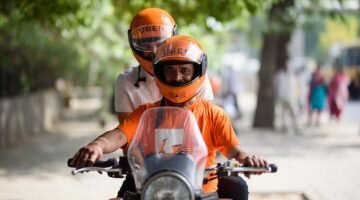Camera in phones has seen quite a life in their own sense. Camera in mobile handsets was a revolution when it first started. Since then it has come a long way. Now, a smartphone camera comes with a number of features including optical image stabilization (OIS), larger sensors, bright lenses, and even optical zoom making them equivalent to DSLR. These features are a blessing to everyone who loves to travel around and want to capture each and every moment of their adventure and experience while traveling. Carrying a DSLR everywhere is quite a task and chances of damage are more. But these camera phones make it easy for every travel lover who wants to save every step as their memory.
Here is the list of smartphones which have the best features in their camera aspect, which a regular traveler should have.
Sony Xperia Z5 Compact:
The Sony Xperia Z5 Compact features a 23-megapixel f/2.3 camera on the back and a 5-megapixel front ‘selfie’ camera, plus the Z5 is also capable of capturing 4K video (at UHD resolution) which makes it ideal for those who are interested in photography. In terms of size, the phone is 5 inches tall and 2.55 inches across from edge-to-edge and it’s waterproof as well as dustproof. Battery life lasts up to 2 days and overall, the Sony Xperia Z5 Compact is a great choice for someone passionate about phoneography but conscious about phone size.
Moto X Play:
The Moto X Play is positioned between the Moto G and Moto X Style as a mid-range model in Motorola’s current smartphone range. The X Play has a 21MP rear camera and 5MP front-facing camera and is fronted by a large 5.5-inch display. Images from the X Play’s 21MP sensor are vibrant, well-exposed and have plenty of dynamic range. If the camera detects a high contrast scene, the automatic HDR mode makes a noticeable difference to highlight and shadow intensity, whilst also boosting colour vibrancy. The effect is very noticeable, although in some instances it can look a little too intense. Things are less impressive in low light, where noise becomes more obvious as the camera requires higher ISO sensitivities to compensate for the lack of image stabilisation.
Samsung Galaxy S6:
The Samsung Galaxy S6 goes head-to-head with the iPhone 6, HTC One M9 and Sony Xperia Z3+. The 16.0MP camera features true optical image stabilisation and a maximum aperture of f/1.9. There’s a front-facing 5Mp camera and the S6 can record Ultra HD video at 3840 x 2160. In good light, the Galaxy S6’s image quality is nothing short of miraculous. Colour reproduction and exposure metering are also first class and the camera produces beautifully vibrant and accurately exposed results. Low light performance is less convincing but there is an excellent auto HDR feature built-in.
Moto G (3rd Generation):
The third generation of the Moto G features a 13Mp 1/3-inch back-illuminated image sensor, 28mm-equivalent lens, f/2.0 with 4x digital zoom and a 5.0-inch IPS LCD screen. The fixed focal length, 28mm equivalent lens produces distortion-free images, while corner sharpness is almost a match for the centre of frame. The front-facing selfie camera generates good enough image quality for social media sharing or 6×4 prints, but when viewed any larger, the lack of fine detail is clear to see. Panoramas are a little disappointing but video, captured at 1920×1080, is well detailed, vibrant and well exposed.
Huawei P9:
The standout feature on the Huawei P9 is most definitely its camera as it features 2x f/2.2 lenses. The phone also has a 5.2inch screen and is capable of recording FullHD video. The P9 looks great and for the most part, performs really well. The camera produces great results and it’s actually bursting with features (once you find them). Those who use their smartphones for taking photos regularly, particularly selfies, will find the auto mode really easy to use and will be more than happy with the shots it produces. Plus, if you do want to dabble with a bit of manual photography, there are the options to do so.
Huawei P8:
The Huawei P8 features a slim metal body, large 5.2inch fullHD screen and a 13-megapixel camera with a bright f/2.0 lens. The phone also has a number of advanced photography features including a light painting mode and optical image stabilisation. Image quality is reasonably good, but not as sharp or as detailed as competitor phones but for those who don’t want to spend as much money, but still want a premium smartphone camera, then P8 is well suited.
Samsung Galaxy S5:
The Galaxy S5 will shoot at an impressive six frames-per-second for a 30-second burst and it’s got enough oomph to record 4K, Ultra HD video. The S5 is also certified dustproof as well as waterproof to a 1-meter depth and is available with 16GB or 32GB of internal storage. As for its picture-taking capabilities, the S5 sports a fixed, 31mm-equivalent f/2.2 lens and features digital image stabilisation. The Galaxy S5 captures good levels of detail from both close range and distant subjects at ISO400 and below. It also maintains impressively low levels of detail smoothing and image noise at higher sensitivities. Colour reproduction is accurate and matrix metering reliably produces well-exposed shots with decent dynamic range.
BQ Aquaris X5:
The BQ Aquaris X5 is a really smart looking phone that’s a decent size and available in a range of colours. The screen on the X5 is an impressive size and offers a decent resolution but it is constructed from Dragontail glass which some say isn’t as good as Gorilla glass found on smartphones which sit higher up the cost ladder. There are two cameras on the BQ Aquaris X5: 5MP selfie camera and a 13Mp back camera that’s powered by a Sony sensor and for its price point, the X5 offers an impressive list of camera features and is capable of producing some great shots. Although, photographers may find the purple fringing and the phone’s occasional inability to cope with wide dynamic ranges annoying but for most people, its selfie capturing capabilities along with its mostly good performance when capturing other types of shots will be enough.
Sony Xperia Z5:
The Sony Xperia Z5 features a 23-megapixel 1/2.3inch Exmor RS sensor, fixed 24mm-equivalent f/2 lens, 5.2-inch touch-screen and loads of features including HDR and panoramic shooting. Image quality from the Z5’s 1/2.3-inch sensor is on a par with that of a decent compact camera equipped with the same size sensor. Faithful colour reproduction and good dynamic range produce vibrant, well-exposed images. Detail captured in close-range subjects is also impressive, but when it comes to shooting more distance scenes like landscapes, Sony’s aggressive noise reduction processing smears some fine detail and produces a slightly painterly appearance when viewing shots at 100% image size. The front-facing selfie camera produces acceptable results, though fine detail is lacking and video captured at 3840×2160 is highly detailed and well-exposed.
HTC One A9:
Sporting a 13Mp camera and 4K video, the One A9 sits just below the One M9 in the HTC smartphone lineup. On the front you’ll find a 5-inch screen and the One A9’s camera can be accessed by swiping the camera icon up from the lower right of the lock screen. The app itself is as clear, responsive and easy to use. Plenty of manual control is provided in Pro mode which is accessed via the mode icon located alongside the shutter release icon. Detail and colour reproduction in shots are good and overall, it’s capable of producing natural-looking images. HDR capture does a decent job of boosting dynamic range and even its low light performance is commendable.


























